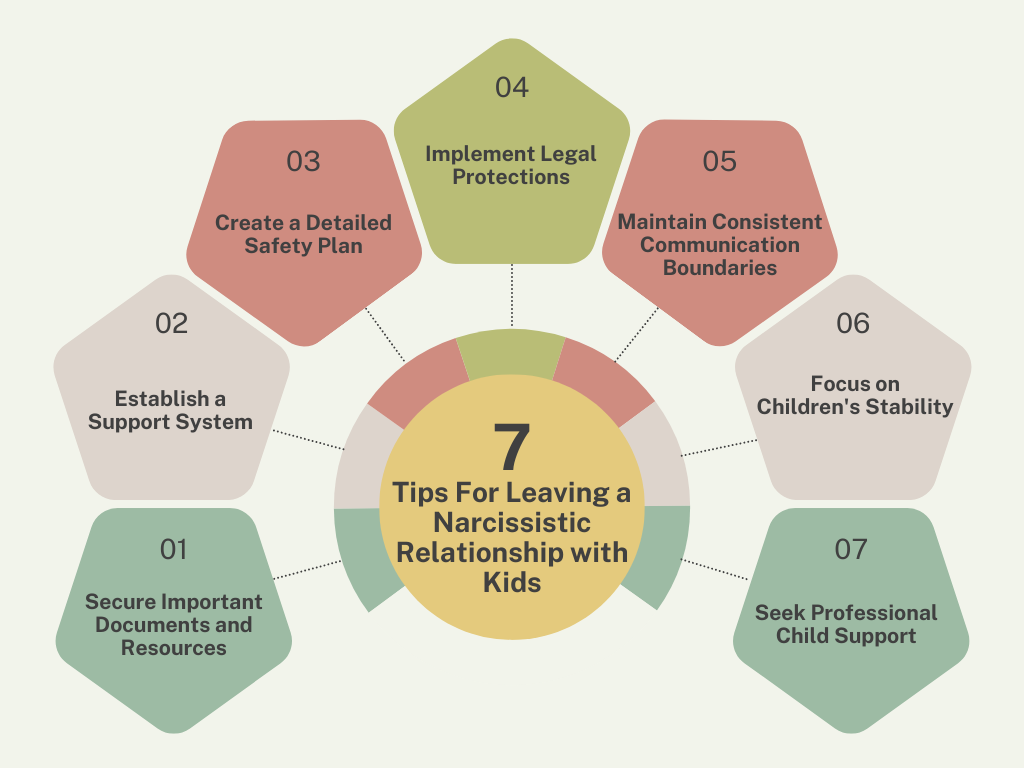Breaking free from a narcissistic relationship takes courage, especially when children are involved. The mix of emotions, practical challenges, and safety concerns can feel overwhelming.
Yet, with proper planning and support, parents can create a path toward a healthier future for themselves and their children.
Moving away from a narcissistic partner requires more than just packing bags and walking out the door. The process needs careful thought, preparation, and a solid plan that puts children’s well-being at the center.
This blog offers practical tips to help make this transition safer and more manageable.
These tips will help parents make informed decisions during this challenging transition while putting their children’s safety and mental health first.
Understanding Narcissistic Traits
Spotting narcissistic behavior helps people protect themselves and their children. A person with these traits often shows a pattern of self-centered actions and needs constant praise.
They might make others feel small while acting superior. Their words rarely match their actions and often blame others for their mistakes.
Many care little for others’ feelings but demand attention and special treatment. Some signs include controlling behavior, emotional outbursts, and using guilt to manipulate.
Research shows varying numbers of Narcissistic Personality Disorder (NPD) in the U.S. population. Studies indicate between 0.5% and 5% of people might have NPD, with males making up 50% to 75% of diagnosed cases.
The real numbers could be higher since many people hide their narcissistic behaviors through subtle or quiet methods. This makes it challenging for mental health professionals to identify and track true NPD cases in the general population.
Tips for Leaving a Narcissistic Relationship with Kids

Now that we understand what Narcissistic behavior is let us examine important strategies that focus on legal preparation, emotional support, and maintaining stability for the children.
1. Secure Important Documents and Resources
Parents need to gather essential paperwork before taking any steps to leave detailed records of any concerning behavior patterns that might affect custody arrangements.
- Keep all vital papers in a safe place away from home – birth certificates, passports, social security cards, and school records for both you and your children.
- Make copies of financial documents, including bank statements, tax returns, and property deeds.
- Set aside money gradually in a private account that can support basic needs for a few months.
- Gather medical records, insurance information, and any legal documents related to your marriage.
- Take photos of valuable items in the home and maintain a detailed list of shared assets.
2. Establish a Support System
Building a network of trustworthy people makes the leaving process less daunting.
- Connect with trusted family members or friends who can offer emotional support and temporary shelter if needed.
- Find a counselor or therapist who specializes in narcissistic abuse recovery.
- Join online and in-person support groups where you can learn from others’ experiences.
- Build relationships with your children’s teachers and school counselors who can help monitor their well-being.
- Contact domestic violence organizations for guidance on local resources and services.
3. Create a Detailed Safety Plan
Safety planning involves mapping out specific steps to protect everyone involved. This means identifying safe places to go in case of emergencies and teaching children basic safety measures without causing fear.
- Map out several possible safe locations where you and your children can go when ready to leave.
- Save important phone numbers, including legal aid, shelters, and emergency contacts.
- Pack an emergency bag with essential items and keep it somewhere secure outside the home.
- Plan your departure for a time when your partner is not present, and have a trusted person accompany you.
- Prepare your children in an age-appropriate way without causing undue stress or anxiety.
4. Implement Legal Protections
Getting legal help early in the process protects both parent’s and children’s rights.
- File for temporary custody orders to establish clear parental rights and responsibilities.
- Keep a detailed log of any concerning behaviors or incidents that affect the children.
- Work with a family law attorney who knows about narcissistic personality patterns.
- Request supervised visits if there are safety concerns.
- Get copies of police reports or medical records if any past incidents occurred.
5. Maintain Consistent Communication Boundaries
Setting clear rules for contact helps reduce manipulation attempts.
- Use a co-parenting app or email for all communications about the children.
- Keep messages brief and focused only on child-related matters.
- Save all written exchanges in case they’re needed for legal purposes.
- Set specific times for phone calls or updates about the children.
- Avoid sharing personal information or emotional responses.
- Have a trusted person review messages before sending them.
6. Focus on Children’s Stability
Keeping children’s routines as normal as possible helps them adjust to changes.
- Help children understand changes in age-appropriate ways.
- Allow them to express feelings without judgment.
- Maintain connections with both sides of the family when safe.
- Create new positive traditions in the new living situation.
7. Seek Professional Child Support
Finding a child therapist who understands narcissistic family dynamics helps children process changes.
- Connect with school counselors to support children during transition.
- Join support groups for children from similar family situations.
- Consider play therapy for younger children.
- Look for local programs specifically designed for children dealing with family changes.
- Meet regularly with professionals to monitor children’s adjustment.
Effects on Children for Leaving a Narcissistic Partner

- Emotional and Behavioral Changes: Children may experience mood swings and show signs of anxiety or withdrawal. They might struggle with trust issues and change their usual behavior patterns.
- Academic Performance: School work may be affected as children process family changes. Some might show temporary drops in grades or have trouble concentrating in class.
- Social Relationships: Children might hesitate to form new friendships or show changes in existing relationships. Some may become overly attached to one parent or distant from both.
- Self-Esteem Impact: Children may question their self-worth and struggle with confidence. They might feel responsible for family problems despite reassurance.
- Physical Manifestations: Stress might show through physical symptoms like changes in sleep patterns or eating habits. Some children may complain of headaches or stomach aches.
- Identity and Role Confusion: Children might struggle with their role in the family, sometimes taking on inappropriate adult responsibilities. They may feel torn between both parents.
- Communication Patterns: Some children become overly careful about what they say to each parent. They might develop patterns of withholding information or becoming selective in their communications.
Conclusion
Now that we have gone through the process of leaving a narcissist, we have to keep in mind that leaving takes time and patience – rushing could put safety at risk.
The goal is to create lasting positive change while protecting everyone involved, especially your children.
The healing process will take time, and each small step forward will matter.
While the path may be challenging, the long-term benefits of establishing a healthy family dynamic make the journey worthwhile.
Stay committed to the safety plan, maintain documentation, and keep children’s needs at the forefront of all decisions.
Frequently Asked Questions
How Do I Get My Daughter Away from a Narcissist?
Document all concerning behavior patterns and work with legal professionals to establish custody arrangements prioritizing your child’s safety.
How Do You Get Child Custody from a Narcissist?
Build a strong legal case with documented evidence, maintain consistent records of all interactions, and work with experienced family law attorneys who understand complex custody situations.
Is it Dangerous to Leave a Narcissist?
Leaving can increase the risk of aggressive behavior, making it crucial to have a detailed safety plan, legal protection, and support system before taking action.








